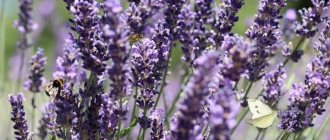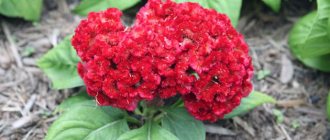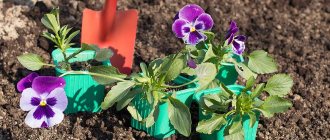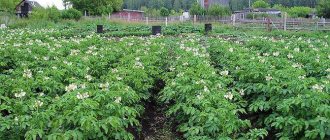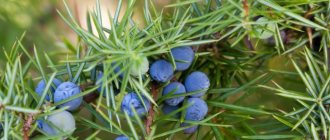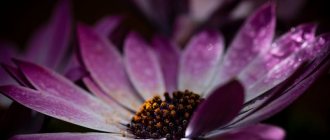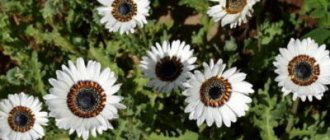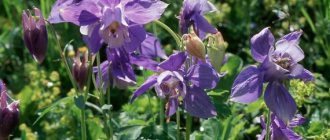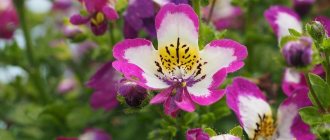Datura care
Stable growth and lush flowering of indoor daturas require following some rules:
- The plant loves good lighting; the soil should be nutritious and loose. High acidity of the soil is neutralized with a “milk of lime” solution. To prepare it, 1 g of lime is diluted in 1 liter of water.
- It is better to water dope about 3-4 times every 7 days, and in especially hot summer times - daily. In winter, watering only once every 7 days is enough.
- During the flowering period, weekly fertilizing with alternating complex and mineral organic fertilizers will not be superfluous. In winter, fertilizing is not needed.
- Only new shoots of the plant are capable of producing flowers, therefore, when flowering on old stems stops, they must be pruned to form a crown.
When growing datura using the seed method indoors, it is necessary to take into account that its seeds are distinguished by the presence of a dense leathery shell, which protects them from drying out, cold and adverse environmental influences. But such a top cover also prevents germination. Despite this, enthusiasts cope with the task and can successfully grow such beauty both in gardens and in apartments.
A plant with huge white flowers, shaped like bells. The spherical fruits have sharp spines. The leaves are large, gray-green in color. In southern countries it is considered a weed.
It differs from the ordinary one in the specific color of the leaves: bluish-green, closer to gray-blue. The flowers are white.
Used by Indians in occult rituals to induce various visions.
Datura stramonium Datura Innoxia Datura metel Datura stramonium Tatula
The "Flower of Shiva", revered in India, has a divine origin. Its flowers envelop the bush with a delicate white-violet blanket, creating a unique spectacle.
It gained its popularity for its unusual bluish-lilac flower color.
Terry
Daturas with double flowers also look great. There are several types and colors. Datura terry white, orange, red, purple and others.
Note that not only Datura has the Terry variety. For example, this is one of the varieties of the mock orange shrub.
A distinctive feature of these species is their light, delicate aroma. They are most suitable for growing indoors.
The undeniable advantage of Datura (Datura flower) is its diversity, which exceeds the expectations of the most demanding gardeners. Apart from its poisonous characteristics, growing garden Datura is a very pleasant experience.
Datura blooms long and profusely, does not require care, and pests avoid it. Datura will be a great addition to landscape design. There is no doubt that keeping the witchcraft Datura at home is a purely personal matter.
People have long known what the Datura flower looks like, and have been growing it for several thousand years. With proper and dosed use, the plant can be used in folk medicine. Datura herb has antispasmodic, analgesic and sedative effects. Based on Datura, medicines are prepared that fight various ailments: asthma, neuralgia, rheumatism, stomach cancer, mastopathy, coughing attacks, etc.
Datura belongs to the Solanaceae family and includes 13 species, which have different descriptions in color, aroma intensity, degree of toxicity, etc. It is an annual herbaceous plant (some gardeners cultivate it as a perennial), with long-petiolate, ovate, dark green leaves, about 10 cm. Flowers are large, single. The fruit of the datura is a large four-lobed capsule with numerous spines, which dries out when ripe.
The plant almost completely contains alkaloids, in the stems - about 0.16%, in the roots - 0.26%, in the seeds - up to 0.22%. In the tropics and subtropics, where wild datura lives, this flower can reach up to 5 meters in length. At home, it is impossible to achieve such growth, since it requires a lot of free space. Under favorable home conditions, you can grow datura up to two meters.
Important! You should not inhale the aroma of datura for too long, and you should not bring bouquets of these flowers into your home. They are poisonous and can cause headaches, and in some cases hallucinations and mental disorders.
However, despite the toxicity of Datura, its decorative qualities and beautiful flowering still outweigh, so the flower is actively planted in dachas and personal plots. The aroma of some types of dope is quite pleasant and helps to mask unwanted and unpleasant odors in gardens and summer cottages. In addition, the plant has an incredibly beautiful color that can vary from white to lilac, purple, violet and even yellow.
Datura grass has some planting features that must be taken into account so that the plant will delight the eye with its color for a long time. It is better to grow the first datura through seedlings. Subsequently, it will reproduce by self-sowing and will take its place in the garden for a long time.
Datura seeds germinate quite slowly, about 30 days. Therefore, to speed up the process, you need to soak the planting material for 2 weeks in cold water mixed with any growth stimulant. The floating seeds are thrown away, and those that remain at the bottom can be sown.
Datura can be cultivated in several ways, the most common of which is growing from seeds. Seedlings are planted in early spring in small plastic containers - cups, food containers. A thin layer of peat, a layer of soil, and then seeds are poured onto the bottom of the container. It is better to cover the seeds with a thin layer of compost, sprinkle with ash and cover with glass.
Datura is a heat-loving plant that dies when the temperature drops below 8...10 degrees, so it is planted in late spring. Mid to late May is a good time, as soon as the ground warms up to 16°C. For planting, you need to prepare planting holes about 60-70 cm deep and about 50 cm in diameter.
Due to its unpretentiousness, the Datura does not require special care. For its good growth, all you need is loose, nutritious soil, pruning and abundant watering, on which the flowering of the plant depends.
Datura requires watering every other day, and if the weather is dry and hot, you need to water every day. When growing plants indoors in winter, watering should be reduced to once a week. If there is insufficient humidity, datura loses buds, flowers and leaves. It is better to water with hard water. The plant loves frequent spraying, especially in the evenings during the hot summer season.
The plant requires active feeding, especially during the development period. At this time, you need to alternately apply complete mineral and organic fertilizers weekly. In winter, when the plant enters a dormant phase, feeding is stopped. If the datura grows on acidic soils, it needs to be watered with lime milk once a season: 1 g of lime per 1 liter of water.
One of the prerequisites for the successful growth of Datura as a perennial is pruning. Datura flowers form only on young shoots, therefore, in order for the plant not to stop blooming, you need to constantly trim off the wilted flowers, leaving the fruits for seeds. The seeds may fall off, so special bags are placed on the boxes. In September, after flowering, the crown should be formed by carefully trimming the branches of the plant.
Wintering of Datura
Datura cannot withstand wintering in open ground, so after pruning the plant is dug up, transplanted into large pots and brought indoors. For successful wintering indoors, the datura requires a constant temperature of 15… 17 °C. During the winter period, the plant sheds all its leaves and forms new shoots with leaves.
In the spring you need to prune new branches, which will give good cuttings that will quickly take root. Later rooted datura cuttings are an excellent material for planting, even more resilient than an overwintered mother plant. Therefore, in mid-latitudes, datura is best cultivated as an annual.
In the natural environment, Datura grows next to housing, in vacant lots, and on roadsides. The plant is considered a perennial evergreen shrub. In the climate of the middle zone, Datura is grown as an annual. Datura belongs to the widespread family of Solanaceae (Solanaceae), a class of dicotyledonous representatives (angiosperms).
Stem
Erect, hollow, complex trifoliate shape. The outer side of the stem is green, allowing for a red-violet tint at the base. The height of the stems can be 120 cm. As the bush develops over many years, the lower parts of the stems become lignified. On the trunks, shoots with dark, oblong, alternately arranged leaves emerge. Each shoot develops on a petiole.
We invite you to read: How to store potatoes in a box in the cellar in winter: optimal conditions and temperature for storing potatoes
Leaves
The length of the leaf reaches about 15 cm, the width is about 10 cm. The surface of the leaf is smooth, dense, similar to leather. The lower part of the leaf plate is painted in light shades. A light stripe runs along the central vein. There are clear teeth on the edges of the sheet. The basal leaves are distinguished by their smaller size, lanceolate shape, and short petiole.
Shoots, flowers
At approximately 30 cm in height, the first shoot begins to develop. Here the stem bifurcates, making room for the appearance of a conical bud; the flower is formed in the form of a long cone, gradually turning into a large funnel with a diameter of up to 20 cm. It opens only in the dark (sometimes in cloudy weather) and lasts one night.
How to grow Datura at home?
Datura is a plant that does not require any special care; even a novice gardener can cope with its cultivation. At home, growing this flower will also not be difficult. Today, several types of datura are known: Datura vulgaris - has fairly large leaves and white inflorescences. Datura Indian - distinguished by the presence of spiny fruits. Datura Indian - has amazingly beautiful inflorescences of a soft purple color.
The Datura bush is quite lush in shape, with stems half resembling wood, reaching one and a half meters in height. As for the foliage, it is egg-shaped and has slightly pointed tips. Particularly noteworthy are the flowers, which are presented in a variety of shades (from white to purple and violet), and also have the shape of a funnel and reach a length of 20 centimeters.
To grow datura at home, you need to follow certain rules:
Growing Datura
Datura is easy to grow from seeds. Planting material can be collected independently or purchased in specialized stores. In February or early March, you can sow seeds for seedlings in the house.
You can collect the seeds yourself or buy ready-made ones.
For better germination, it is better to pre-soak them. The planting depth should not exceed 0.5 cm.
Be sure to take cups or boxes for planting that are deep: the roots of the seedlings will grow quickly. A thin layer of peat is placed on the bottom. The soil must be chosen fertile and light, add river sand to it and steam well.
Datura (Datura) seeds are very tenacious. Subject to storage conditions, they will not lose their germination quality for 10 years. In order to make sure that the planting material has not deteriorated, it is filled with hot water.
Seeds suitable for use will remain at the bottom, and those that float to the surface are rejected. The percentage of germination and germination is amazing. 95% of seeds germinate. Germination time can vary from 10 to 50 days.
| Growth stimulants | Before planting, you should soak the seeds in a solution of epin or zircon |
| Greenhouse effect | Moisturize the soil · plant seeds Irrigate with warm water Cover with film or glass, creating a greenhouse |
A growth stimulator helps speed up seed germination.
After the seeds have hit the ground, you need to:
- Maintain the air temperature around 25˚C, as soon as the first shoots appear - 18-20˚C.
- Young shoots will need a lot of light to prevent them from stretching out.
- “Children” of Datura should be treated with any fungicide as soon as they are born. This will eliminate the possibility of being affected by the “black leg” disease, to which seedlings are highly susceptible.
The grown sprouts are transplanted into a pot, and when the first leaves appear, they are plucked. Water regularly 3 times a week. When the threat of frost has passed, Datura is moved to outdoor conditions for permanent residence.
It grows quickly. Already in June, its flowering can begin, which will last until September.
Datura grown in open ground will be noticeably different from indoors in its chic forms. Datura in pots is always small in stature, its inflorescences are unevenly formed.
The difference can be clearly seen if you transplant Datura from a pot into open ground.
In just a couple of months, the “devil’s flower” will turn into a massive shrub one meter high and covered with an incredible number of inflorescences. Its intoxicating smell will be felt in every corner of the garden.
The pet can grow to a large bush
It is for these reasons that the popularity of outdoor cultivation exceeds the pot method.
You can grow Datura grass for open ground by seedlings or sowing. Germinating Datura grass seeds for planting in open ground is fundamentally no different from the method that is applied to potted plants.
Datura seedlings
Datura seedlings should be planted as follows:
- Plant only when the air temperature no longer drops below 3˚C. This time falls at the end of May - beginning of June.
- Choose a place protected from the winds so that the plant can grow to its full potential.
- The soil must be loose and have good fertility.
- Complex mineral fertilizers are applied immediately. In the future, this will need to be done once a week. Fertilizing increases the duration of flowering.
Before fertilizing, it is necessary to moisten the soil. During extreme heat, it is better to avoid using various medications. This can lead to the death of the plant.
- When placing the sprout in the ground, it is watered with rainwater and sprinkled with soil on top. Such actions will prevent rapid evaporation of moisture.
- The distance between “Daturyats” must be at least 1 meter. As the plant grows, it requires a lot of space.
Growing datura grass from seedlings allows you to get seedlings faster than when growing from seeds
Datura seeds
Datura can be sown directly in open ground. This method will appeal to those who are not friends with seedlings. You should only take into account that the seeds can germinate if the planting depth does not exceed 10 cm, and the night temperature does not drop below 15-20 °C.
There is no need to fertilize immediately, but you must water it once every 3 days.
You can start by choosing a place in the garden where you plan to further grow datura grass. Like many exotic plants native to Asia, Datura loves a lot of light. Therefore, in the garden you need to choose the sunniest place where there is no wind.
Datura seedlings can be planted in open ground at the end of May and the first weeks of June. An adult Datura will grow quite large, so there is no need to limit it in space. This will be the main factor when planting sprouts obtained from seeds. The ideal planting pattern is 1x1 m.
Seeds of annual datura, which is much more common in gardens, can be grown without seedlings. That is, plant immediately in open ground. One-year-olds include such species as blizzard dope and Indian (harmless).
They can be planted in one of the periods - late spring or early summer.
A plot of land for growing datura is prepared in the fall. Dig up the top layer and apply fertilizer.
Datura is considered a heat-loving plant. Therefore, seeds planted in open soil must be covered with polypropylene fiber to protect them from frost. This way the plant will receive light, warmth, and fresh air.
By the way, growing datura from seeds by planting them directly in the open air does not bring rapid flowering. Seeds planted for seedlings at home will bloom within three weeks. While in open soil they bloom much later.
Surprisingly, in some countries, Datura grows as a simple weed. It is not so rare to see him in photographs in travel magazines. In our country, datura is grown from seeds in order to later become a decoration of flower beds and gardens, filling them with a pleasant aroma. Of course, due to the fact that the plant is poisonous, it is not recommended to grow it for those who have small children.
But not everyone is ready to deny themselves the pleasure of enjoying the view of the beautiful flowers of this plant, and, tired in the evening after a hard day, relaxing to the light sweet notes of large bells.
The homeland of Datura, as well as most exotic plants, is Asia. Today the plant is cultivated as a garden plant in many countries around the world, and in some of them it grows as a weed.
The homeland of Datura is Asia
Datura is a perennial, highly branched herbaceous plant with a powerful root system, reaching a height of up to 1.5 m. Datura flowers can be white, yellow, violet, pink and even purple. The fruits of the plant are ovoid, multi-seeded, four-leaf capsules, entirely covered with small thorns on the outside.
We suggest you read: What is the most effective ant repellent?
In many countries around the world, datura grows like a weed.
Growing Datura is a simple process even for a novice gardener, but I’ll tell you one secret - Datura feels best on an ordinary manure or compost heap. Not knowing how to disguise a manure heap, I had been selecting a plant for it for a long time and, after reading the recommendations of numerous gardeners, I chose the datura, which was just perfect.
Datura feels best on a moist manure or compost heap.
In central Russia, datura is grown as a seasonal annual, but if you remove the plant indoors before the first frost, it can also be grown as a perennial. True, this requires space; growing datura on a windowsill will not work; in my room it has won a corner of 1.5 m2.
The soil mixture for sowing datura seeds must be prepared in advance; I do this in the fall. Ideally, it should consist of 2 parts of sifted garden soil, 1 part of large river
and 2 parts
. I sow Datura seeds for seedlings at the end of March, and in open ground at the beginning of May, choosing the warmest sunny places for its cultivation.
Due to the fact that Datura seeds have low germination energy, its first shoots appear only 10-30 days after sowing. In order to speed up the germination of seeds, I give them pre-sowing preparation: I fill them with hot water, throw away the ones that float, and sow the rest.
Datura can be propagated by seeds
Before germination, the soil must be constantly moist; for this I cover the container with the seeds with plain paper. After the first sprouts of the datura appear, I transfer the seedlings to a fairly cool but well-lit place. With the appearance of two true leaves, I begin to pick them. I carefully plant the seedlings, burying them under the very cotyledons, which only benefits the plant.
To plant the datura, you need to choose a sunny place without drafts.
I plant Datura in open ground at the end of May. I leave the distance between the seedlings about 1 m from each other, I repeat - the plant really loves space. To plant datura, you need to choose a windproof, sunny place without drafts, which the plant does not tolerate.
Datura seeds germinate from a depth not exceeding 10 cm, remember this when sowing the plant directly into open ground. The flowering phase of dope begins 3 weeks after sowing.
The unpretentious Datura plant does not require special skills when growing. In order to get a beautiful plant, it is enough to simply provide the dope with nutrition and moisture.
This is a fairly light-loving plant, so for planting it, choose open, sunny places that are not exposed to strong gusts of wind. The plant has rare seed germination (up to 95%), which germinate faster when the temperature rises. Seeds can germinate in a week or two if the temperature rises to 25... 28 °C. The plant is sown in the spring: in open ground in May, for seedlings - in late February - early March.
Important! Do not forget that datura is a poisonous plant, therefore, it does not belong near playgrounds or in places where children often visit.
Datura in the open ground
Datura grown in containers is usually short. Inflorescences are formed unevenly. Planting directly into open ground can give amazing results.
In just a few warm months, Datura will turn into a massive shrub, up to one meter high. Abundant flowering will cover the datura. The heady aroma of the inflorescences can spread throughout the entire area.
It is necessary to plant the plant outdoors after the threat of morning frosts has subsided. Datura can die from a sudden drop in temperature below + 3 degrees.
You should choose an area protected from drafts and wind. The soil must be loose and fertile.
For remontant (long-lasting) flowering, you will need to regularly fertilize the soil at the base of the plant. To do this, you need to use complex mineral compounds once a week. Half an hour before feeding, be sure to moisten the soil. The use of drugs in combination with hot weather is detrimental to Datura.
In the garden, Datura grows remarkably well as a single crop. Growing in groups or in the shade of other flora can stunt the flower's development.
The nuances of planting seedlings in open ground can be learned from the video:
Facts about the flower
Gardeners successfully practice growing blue datura and other species with seeds; they ripen by the end of August. Those that were collected after the first flowering have the greatest germination; they are dried and stored until spring. To save the seed so that it does not scatter, the method of wrapping the boxes in gauze bags is used.
Sowing begins in February (in the last days) and is completed in early April. The seeds have a long shelf life; their ability to germinate is not lost for 10 years. But before landing they must be checked first. Why do you need to soak the seeds in hot water: add the contents of the package and collect those seeds that float to the surface, and those suitable for planting - continue to soak for about two days.
Datura has one specific weakness: it and all nightshades are easily infected with fungal diseases, for example, blackleg, in the early stages of development. To avoid pest damage, they practice treating swollen seeds with a solution of potassium permanganate before planting. Why is the seed soaked for half an hour? It is recommended to pre-calcinate the soil or treat it with boiling water, adding potassium permanganate until it turns dark pink.
The boxes and cups for sowing are of sufficient depth, because datura is characterized by rapid development of the root system, and a thin layer of peat is poured at the bottom.
Light and loose, but fertile soils are well suited for cultivation; they should be easily permeable to water and air masses. It is permissible to plant using ready-made store-bought mixtures for growing pepper seedlings. To make it yourself, you need to add coarse river sand to the garden substrate (it should be fine and washed to remove clay inclusions), last year’s humus and steam it.
It is preferable that the rotted organic matter contains sawdust, this contributes to additional loosening of the soil. In an area with heavy soil, the situation will be corrected by adding ground eggshells or chalk to the soil (a tablespoon of additive per kilogram of mixture).
The prepared seed is placed in moist soil to a depth of no more than 1 cm, then the crops must be sprinkled well with reseeded wood ash on top. This helps to protect young seedlings from the fungus before the first watering if its spores end up in the substrate. Next, the crops should be sprayed with warm water and covered using glass or cellophane and placed in a warm place.
In small greenhouses it is recommended to maintain the temperature at 18-20°C.
Datura has seeds with high growth energy, germination is observed already 14 days after sowing, but sometimes, under unfavorable conditions, they remain in the ground for 30 days.
When the first shoots hatch, the boxes and containers are opened slightly so that the humidity level in the greenhouse is equal to the surrounding environment, and they are placed in sufficiently lit places. After a day, the shelter can be removed completely. And if 2-3 true leaves appear, it’s time to pick the plant.
Seedlings of indoor varieties are placed in tubs or pots deepened to the cotyledons. Young shoots require regular, but not excessive, watering.
Sprouts that are planned to be grown in open ground must be hardened; the period lasts 30 days. When the night temperature is fixed at at least 10°C, the grown seedlings can be stopped from being brought indoors from the street at night.
In the last days of May, the garden datura is ready for planting in a permanent place. To do this, it is preferable to choose a sunny flower bed in a place where there are no drafts.
Plant seedlings are planted at a distance of at least 1 m from each other.
Description
Datura has a wide growing area. Devil's weed is native to Asia. She feels great in Crimea, southern Russia, the Caucasus, Ukraine and Western Siberia.
Wild Datura grows near houses, in vacant lots, and near ravines. The flower loves loose, moist and nutritious soil. Usually grows in clusters.
Any gardener can cope with Datura grass on a personal plot. The flower is completely unpretentious to watering and care; it practically grows on its own. In the middle zone, its seeds rarely ripen, and it is considered an annual.
In the southern regions, Datura grows by self-sowing from year to year and can occupy large areas, sometimes it is equated to a weed.
Datura is an annual light-loving plant, reaching a height of more than 1 m. It grows in the form of a bush. It has large and very beautiful flowers in the shape of a bell or funnel.
We suggest you read: Planting viola for seedlings How to grow viola
Flowers can be of various shades, but most often white. Unfortunately, Datura flowers quickly wither. This is compensated by the fact that there are a lot of flowers on one bush and they bloom quickly.
Datura is a nocturnal plant; in the evening the buds bloom and emit a sweet aroma, which is not recommended to be enjoyed for a long time.
Breathing in the aroma of datura for a long time is strictly contraindicated.
| In ancient times | nicknamed the "mad potion" was used to poison victims and traitors |
| Today | All parts of this plant are poisonous. Its use can cause hallucinations and even drug intoxication. |
That is why, for those who have young children and inquisitive animals in their home, it is better to refrain from growing it in their garden.
If you are concerned about the topic of dangerous plants, then an article about the 10 most poisonous indoor plants will be interesting.
Few people know that the plant can be grown at home. With the onset of autumn, you can dig it up in the garden and plant it in a voluminous tub. Thus, Datura will grow in the house for many years.
Such a beauty will need a large and bright room. In summer it should be taken out into the fresh air in the garden or on the balcony. With the onset of autumn cold, they bring it into the house.
In the cold season, the plant is removed indoors
In winter, it needs regular watering and being away from heating radiators.
At a young age, feeding is not required until the first flowering. Then alternate mineral and organic fertilizers every week. In winter, give the plant a break.
Having a Daturu in your home means being a great original. When you find a datura flower in the house, do not forget about its poisonous qualities.
Use of datura herb in medicine
Even in ancient Greek medicine, dating back to the 4th century BC, many healing properties of henbane are described. For example, the 11th century physician Avicenna described this herb as an excellent narcotic
.
But of course, the medicinal properties of a plant depend on its alkaloid content. Thus, hyoscyamine helps reduce the secretion of bile, sweat, saliva, and also stimulates cardiac function.
.
In the modern world, the pharmacological industry produces a wide variety of drugs that contain dope, and they are perfect for treating the following diseases:
- Bronchial asthma.
- Bronchitis.
- Stomach ulcers.
- Duodenal ulcers.
- Colitis.
- Cholecystitis.
- Tachycardia.
- Sea and air sickness.
- Mental illnesses.
- Neuralgia.
- Rheumatism.
Decoctions of Datura are used in medicine
, which is ideal for rinsing and rubbing, enemas or douching. Datura oil tincture is used externally. But for constipation, it is also possible to take it orally. And the oil is great for hair removal. There is also dry powder from dope leaves, which is added to special cigarettes for asthmatics.
“Crazy grass” is also used in veterinary medicine, for example, to treat seizures
in cattle or to increase the fat layer of meat in pigs.
But it is always worth remembering that if the dosage for a person is calculated incorrectly, this can be fatal. it is not advisable to use Datura for self-treatment without a doctor’s recommendations and consultation.
.
Procurement of plant raw materials
Traditional healers try to collect dope themselves, but to do this they follow a few simple rules: it is worth collecting in the warm season
, the weather should be clear and sunny and this should be done no earlier than 10 am.
But you should definitely take some precautions. For example, you should not take this plant with your hands, but use gloves for this purpose
You cannot dry this raw material at home, much less in the oven.
The finished raw materials are divided into leaves, flowers and seeds and prepared separately in tightly closed jars. Such preparations can be stored for 2 years. After any work with the plant, you must wash your hands well.
.
Decorative use of Datura
Some varieties of Datura are used in garden plots and as ornamental plants.
Many gardeners like it for its ease of care. Its reproduction occurs by seeds. In the spring, the seeds, soaked in hot water, are planted in pots with soil prepared in the fall. At the end of May, the resulting seedlings can be planted in open ground. After 3 weeks, the first buds will begin to appear. Datura grass flowers photos can be found on many Internet sites or in encyclopedias.
Datura is planted in dachas mainly because of its beautiful flowering. The natural color of Datura is white, but you can also find hybrid forms of this plant that bloom in lilac, violet, purple and yellow
flowers. The incredibly pleasant aroma of flowers helps to mask many unpleasant odors in garden areas.
Caring for dope includes three main conditions:
- Sun;
- loose soil;
- timely watering.
But on the other hand, weeds do not form near the dope; the poisonous plant does not allow them to come near it. But it is still necessary to nourish the soil with various minerals.
It is worth remembering that Datura is a perennial herb, so it does not need to be pruned.
bush completely, and leave for the second year. By the way, a tincture from this toxic plant can also be used to control pests: spider mites, cabbage moths, lacewing caterpillars and hawthorns.
Beetles and ants are not afraid of this plant, but wireworms can even damage these stems. Bees readily collect nectar from this flower, but humans cannot eat such honey.
For the winter, this grass can be transplanted into pots and even taken home, but on condition that they will be in a large room
. This plant cannot be placed in the bedroom or on playgrounds.
Propagation of Datura by cuttings
and 2 parts
Datura reproduces well and
. Why, in mid-September, cut a non-lignified cutting of a plant with 2-3 internodes and root it - in plain water or directly in the soil. In May, the plant, rooted in the fall and already fairly grown, must be planted in open ground.
Datura reproduces well from cuttings
If you grow datura as a perennial, moving it indoors for the winter, then you can root the cuttings throughout the year.
Datura can be propagated by seeds or cuttings. In natural wild and natural conditions, this flower reproduces by seeds.
For home seed propagation, you will need to collect the seeds yourself from ripe fruit “pods” (or buy seeds in a store). Externally, the “boxes” look like a prickly egg.
Inside which there are more than 500 seeds, usually black. Next, germinate the seeds and pick out young plants, as described above.
Cutting method
Datura can also be propagated by cuttings that have not yet become woody. In the summer, they are rooted in nutritious humus and pruned. The cuttings overwinter in a warm place, and as soon as the frosts are over they can be planted in outdoor soil.
How to plant dope seedlings correctly?
Sowing time ranges from February to April. You must first sort the seeds: leave them in a container with hot water for several hours.
Specimens that have surfaced are not suitable for landing. Water the soil in the containers for seedlings and slightly deepen the seeds. Then sprinkle a small amount of soil on top (0.5 cm will be enough).
There is no need to grow many seedlings in one bowl. Keep the soil moist by covering the containers with a sheet of plain paper. Crops should be kept at a temperature of about 15 degrees, and seedlings will appear within two to three weeks.
Seedlings picked into individual containers are germinated in a well-lit place. By the time of planting in the garden, the seedlings should reach 15 cm in height. When transplanting into open ground, you need to try not to damage the roots.
To speed up the germination process of seeds, you can pour them with a concentrated solution of potassium permanganate for a couple of hours. During this time, the shell will become softer, and, as a result, seedlings will appear much faster.
Or moisten the seeds, put them in a bag or resealable container and place them in a warm, well-lit place. When sprouts appear, sow one seed per container.
Datura: picking seedlings
Datura is a rather sensitive flower, so there is no need to pick it before planting it in separate pots. When planting seedlings, the plant is picked as soon as a couple of leaves appear. Seedlings are planted in separate containers, slightly buried (no more than 1 cm). If seedlings are damaged by the “black leg”, picking can be done at an earlier stage, but the survival rate of the plant is reduced.
Planting of datura seeds usually occurs in late March and early April. To get good seedlings from seedlings, you need to take into account some features of this plant. And a reserve of patience will come in handy, because datura sprouts only 15-20 days after sowing.
The soil for datura seedings should be light but fertile. At home, soil can be prepared in the fall by taking equal parts of soil from the garden and humus, and adding 1 part of river sand. It's good if the sand is not fine.
Now you can start choosing containers for the greenhouse. It is worth considering here that the roots of Datura are strong and grow quickly. Therefore, prepare a deeper box. Peat can be spread in a thin layer at the bottom of the future greenhouse.
Datura grass seedlings do not need to be placed deep into the ground. The seeds will feel comfortable at a depth of 0.5-1 cm.
After the seedlings are planted, the soil above is lightly watered. You can use a sprayer to saturate the soil evenly. Planting the seeds is completed by covering the container with film or glass. Next, the greenhouse will need to be placed in a place where a constant temperature of 18-20 C is maintained.
After a couple of weeks, when the first shoots of the datura appear (the first shoots will be like in the photo), you can move the box to a bright place. Now you need to water the plants more often, while making sure that the soil is not too waterlogged.
You can begin to harden seedlings from the appearance of the first leaves. For the first time, two hours in the fresh air is enough. Then it is advisable to increase the time intervals. After a month, the sprouts will become stronger and can be left outside at night. It is only important to ensure that the temperature at night does not drop below 10 C.
How to grow Datura from seeds at home?
Datura is a plant that is usually called simply Datura. Although it is poisonous, it is often used to decorate gardens and summer cottages. This is largely due to the fact that datura - growing from seeds at home does not require much time and effort - has a rather attractive aroma that comes from the large white flowers of this plant.
Main features of the content
If Datura is left outside in the middle zone with cold winters, it will die. If desired, adult plants can overwinter indoors, but in a cool place. Gardeners dig up Datura in the fall and replant it in a tub, cutting off excess stems.
During wintering, the flower undergoes preventive pruning; it should not be moistened often.
This method of preserving a plant is in little demand - the flower loses its viability compared to those propagated by cuttings or grown from seeds. As a result, Datura grass is grown as an annual plant.
Flower in religion and occultism
Mentioned in various ancient cultures. For example, in Mexico, priests used this plant for various religious rituals and divine rites, using it to go into a state of trance. They believed that Datura thus helped them communicate with the spirits of dead people.
In India, the plant was used to carry out insidious murders. For a long time, there was a whole science of preparing poisons from dope, which was taught only to a select few.
Europeans took a more practical approach and began to explore the medicinal properties of the plant.
This led to the fact that already in the 14th century it was used in surgery as an anesthetic for patients. Later, it was found to have sedative, antiseptic and antispasmodic properties, due to which Datura is now grown as a medicinal crop for pharmacological needs.
Datura cuttings
Datura propagates well by cuttings of 10-20 cm, which quickly take root in water, light substrate or sphagnum moss. Cuttings may have one, two or several internodes; cuts should be made directly under the node, removing half of the leaves. When cuttings are taken in the fall, the seedlings must overwinter indoors; with the onset of spring, when the soil warms up sufficiently, they are transplanted into open ground. You can root the cuttings in the spring, after trimming the mother plant overwintering in the house, then the grown datura will bloom in the same summer.
Description: varieties and varieties of datura grass
Datura is an annual shrub with shoots 1-1.5 m long in open ground. Grows more in width than in length. The plant is densely covered with green-gray foliage. The young bush in the photo resembles eggplant seedlings.
Common varieties of Datura:
- Common - huge leaves and snow-white flowers;
- Indian - purple-white buds;
- Indian is a vigorously growing shrub with white petals and an unpleasant aroma.
With proper care, Datura forms huge bells with a delicate aroma. They wither in less than a day. Flowering begins in early summer, becomes widespread only in August, and ends in October:
16 excellent varieties of plums for the Moscow region
- First, Datura forms a shoot about 30 cm long.
- The shoot bifurcates and releases a bud. It gradually grows to 20-25 cm.
- After ripening, the bud quickly opens. The flower is a bell 15-20 cm in diameter.
- The color of the flowers is usually white, sometimes with cream, lemon and other pastel shades.
Photo of Datura common
Datura common is known to many as an annoying and very poisonous weed, but not everyone knows that this plant can be planted as an ornamental crop. Planted on your site, such a plant will become an excellent decoration, while it requires minimal maintenance.
Picking and transplanting
To make it easier to pick the sprouts, the seeds are planted 3 centimeters from each other. Nevertheless, picking the sprouts is mandatory. This procedure is performed when three true leaves grow on the sprouts.
If Datura is grown for open ground, then for temporary cultivation take a small pot with a diameter of at least 7 centimeters. There should be as many pots as there are sprouts.
They are filled with the same soil in which the seeds grew, then a small hole is made in the center of the pot, where, using a spatula, the sprout is carefully placed along with a lump of earth on the roots. The top is lightly covered with earth. Compacting is not recommended, otherwise the roots will not be able to access oxygen.
If datura is grown as an indoor flower, then take a large pot at once. A thick layer of drainage is poured onto its bottom. It may include such materials as: large pebbles, crushed stone, parts of brick, ceramics.
The same composition of soil that was on the seedlings is poured on top, but they are poured not to the very edge, but retreating from it by 5 centimeters. A hole is made in the center, where the sprout is carefully planted without removing the soil from its roots. As the plant grows, the soil needs to be replenished a little.
Datura does not like cramped conditions, so after some time she will have to be transplanted into a larger pot. Further care consists only of timely watering. It should be remembered that datura does not like overflow.
The plant is transplanted to open soil only when the weather is warm and no frost is expected. First, choose a place for it; it should be sunny and without drafts. The planting diameter should be at least a meter, since an adult plant takes up quite a lot of space.
Do not take the pot of Datura outside to harden before transplanting it directly. They are replanted together with soil from the pot, after which a little soil is added on top. If the summer turns out to be dry and hot, then it is recommended to water the flower additionally.
There are special annual flower varieties that can be planted directly in open soil. It is Indian and broom. They are usually planted in May-June. First, they dig up a plot of land, add complex fertilizers, after which they throw one grain at a decent distance from each other.
Cover all this with polypropylene fiber so that sudden frosts do not destroy them. This fiber will not only protect the sprouts from the cold, but also provide light, heat and oxygen.
The film is finally removed only when the air temperature remains above 25 o C for about a week and the sprouts already have more than three true leaves.
Description
The datura flower is world-famous as Datura, since in ancient times sorcerers used its seeds to make a hallucinogenic drink, with the help of which they caused mass visions or turned a person into a zombie. And now from some of its species in pharmacology they make tablets for motion sickness, tinctures for radiculitis. Previously, anti-asthmatic cigarettes were made from it.
Since Datura is poisonous, it is grown with caution, especially if the family has pets or small children who can taste its leaves and buds.
In some varieties, the buds and leaves thin out such a sweetish and cloying aroma that the owners may get a headache. Therefore, a pot with it is not placed in the bedroom, as they bloom in the evening.
If in Russia it is specially grown to decorate summer cottages or premises, then in tropical countries it grows everywhere as a weed.
It cannot withstand winter, so every autumn perennial varieties are transplanted into a pot and transferred to a cool room. During this period, it sheds its leaves and stops blooming. All winter it is enough to water it lightly.
The most common buds are tubular (15 cm in diameter and 20 cm in length), in second place are terry ones, which are not inferior in diameter to tubular ones. There are different colors: purple, orange, white, yellow.
Caring for dope is not at all difficult; even a novice gardener can grow it without any problems if he follows simple rules.
Soil preparation and sowing
Datura loves fertile but light soil, like tomatoes and eggplants. If it is not possible to purchase such soil in a store, then you can make it yourself. To do this, mix regular soil from a summer cottage in equal parts, add humus and river sand. It is advisable that the sand is not fine.
The soil, if it is collected on the street and not purchased in a specialized store, is calcined in the oven to get rid of harmful bacteria and microorganisms that can destroy the datura at the germination stage. If there is no oven, then the entire soil can be treated with boiling water in which potassium permanganate is dissolved.
If the soil from the summer cottage is too heavy, then add a little chalk or crushed eggshells. For looseness, you can add a little sawdust.
To ensure that the grains germinate properly, follow these simple rules:
- Since datura roots grow long, choose a rectangular and deep box with drainage holes.
- The box is placed on a pallet and completely filled with soil.
- Water the entire soil thoroughly to ensure there is enough moisture for a long time.
- The seeds are evenly laid out on the surface of the soil at a distance of 3 cm from each other.
- Cover the top with dry soil no more than 1 centimeter thick.
- All this is dusted with fine wood ash, which will protect the sprouts from accidental fungi.
- The box is covered with waterproof transparent film or glass and placed on a sunny windowsill. The air temperature should be from 25 o C to 30 o C.
Next, you should be patient, as the grains germinate very slowly. It usually takes at least three weeks for the first leaf to appear. All this time you need to make sure that the soil is not dry. And moisten it very carefully, slightly opening the edge of the film or glass.
Only after the first shoots have hatched, the film is opened halfway, but not completely removed. After two days, the film or glass can be completely removed.
During active growth, Datura needs a lot of moisture, but it is not advisable to keep the upper part of the soil wet so that fungi do not multiply on it.
Therefore, they water by pouring liquid into a pan, from where the dope roots themselves absorb as much moisture as they need. If after six hours the moisture remains in the pan, then it is drained.
The most difficult thing in this matter is watering. To understand whether there is enough moisture in the box, you need to poke your finger into the ground to a depth of 1.5 cm; if the soil there is wet, then there is enough water.
Sowing seeds
Datura seeds remain suitable for sowing for a very long time: they germinate even after 10 years of storage. When purchasing seed in a store, a florist practically cannot buy old and unsuitable seeds there. But before sowing, you still need to sort non-viable, puny grains from high-quality ones that will give strong shoots.
For this purpose, the seeds are subjected to flotation. Pour the contents of the bag into a small but deep container (plastic cup) and pour in warm water. Unsuitable seed floats to the top because the grains are not sufficiently developed and are therefore light. The same thing will happen if they are not ripe and dry out during storage: high-quality seeds will sink to the bottom.
After removing the puny grains and most of the water, leave the seed material to swell for 48 hours. There shouldn't be too much water. Its layer should be approximately equal to the size of the grains, and if it has time to evaporate, then liquid can always be added.
Like all nightshades, datura is susceptible to fungal diseases (blackleg) at an early age. To prevent this, before sowing, it is best to soak swollen seeds for 30-40 minutes in a dark pink solution of potassium permanganate. It is advisable to calcinate the substrate in advance or pour boiling water with the addition of potassium permanganate (dark pink solution).
Agricultural technology for growing datura vulgare
Although the common datura is an unpretentious plant, due to its rather powerful structure it requires regular attention. Due to the large leaves, the plant loses moisture very quickly, so it needs abundant watering and frequent feeding.
- Watering. Datura vulgare needs very frequent watering, because the abundance of flowers on the plant depends on it. An approximately mature datura plant needs to be watered every other day, and in the hottest time, watering can be done every day. At the same time, Datura responds well to humidifying the air around it. To do this, you can spray the bush with a hose. It is worth remembering that this plant reacts sharply to increased water hardness, so it is worth watering the dope with settled water and watering the bushes with lime mortar at least once a season.
- Feeding. Datura grows as a rather powerful and large herb, so this plant needs a lot of nutrients throughout the entire season. To do this, every week the datura vulgare needs to be fed with complex mineral fertilizer.
- Loosening. At the very beginning of growth, it is necessary to periodically loosen the soil around the plant and remove all weeds. However, after growth, the dope densely covers the soil and weeds simply do not grow there.
- Trimming. For longer flowering, it is recommended to regularly trim off faded buds and damaged leaves. Also in the fall it is necessary to cut off the seed pods, leaving only a couple of pieces to obtain seeds.
- Wintering. In our climate, Datura is grown as an annual plant, but you can try growing it into a perennial. To do this, in the fall, all shoots are cut off, and the root part is dug up and transferred indoors in a container. During winter, the plant requires moderate watering. In the spring, the common datura is planted again in a permanent place in the garden.
Planting and propagation
Datura is a very unpretentious plant, but it is also important to prepare for its planting so that in the near future a luxurious bush of snow-white flowers will appear on your site.
Preparation
Preparation of planting material for breeding dope:
- First of all, you should buy Datura ordinary, or collect its seeds with your own hands.
- It is better to choose freshly harvested seeds, as this increases the percentage of grown seedlings.
- You can buy ready-made seedlings from your friends if this plant is not yet growing in your garden. This must be done at the end of May or at the beginning of June.
- Ready-made seedlings can also be purchased in specialized stores that professionally grow plants.
- Before purchasing, carefully check the quality of the seedlings. There should be no noticeable damage or signs of disease. The soil in pots should be moist and clean.
- The choice of a specific variety depends on your preferences. As a rule, they plant a plant with snow-white flowers on their plots - it looks simply gorgeous, especially during flowering.
Preparing the soil for planting dope:
- Datura ordinary loves to grow in nutritious, airy and light soils.
- It is better to give preference to soil with a neutral reaction, or slightly alkaline, but not acidic. If the soil on your site is highly acidic, add a little lime to the soil before planting seedlings in the ground.
- It is desirable that the soil is well-permeable to moisture and air, rich in organic matter and well-drained.
- As a rule, the soil for planting is prepared in the fall. To do this, it is very important to dig up your chosen area well; be sure to add a little lime and humus to make the soil more nutritious. At the end of processing, loosen and level everything.
Landing
- Datura seedlings are planted in open ground at the end of May or at the beginning of June, when the ground has warmed up well.
- You can immediately sow the seeds of the plant into the ground, but in this way you will wait a very long time for the first flowering of Datura.
- The soil prepared in the fall is once again well loosened and small planting holes are made in them.
- It is very important to remember that Datura is a very powerful plant that grows very strongly in all directions in a short period of time. It is for this reason that planting holes should be made at least one meter apart from each other.
- A drainage layer can be attached to the bottom of the holes to avoid stagnation of water at the roots of the plant. You can use small stones or coarse sand as drainage.
- Seedlings must be well watered before planting in a permanent location.
- Place each seedling in a separate hole and sprinkle them with soil, carefully compacting it with your hands.
- After planting, all seedlings must be watered generously.
Seeds
- Seeds are sown in early February or March. If you plan to plant in open ground, then in May.
- Seeds take a long time to germinate. If you increase the temperature level to +25+26 degrees Celsius, the plant will sprout in almost 2-2 weeks.
- It must be remembered that seedlings are afraid of drying out the soil and too much watering.
- Flowers sown in separate pots should not be picked.
- Before sowing, seeds should be soaked in water with growth stimulants. This guarantees better germination. The grains must be kept in water for about two weeks. The container is kept on a light windowsill.
- The resulting seedlings should be hardened off before planting in the garden. Thus, at first it is enough to move the plants into fresh air for two hours. This time is increased little by little. Already a month later, the seedlings are left outside all night, provided that the temperature level is at least +10 degrees Celsius.
- As soon as the soil warms up to +16 degrees Celsius, the seedlings are planted in open ground.
Cuttings
Propagation by cuttings is an extremely simple method, thanks to which the roots grow very quickly. For rooting, you should use sphagnum, water, or soil. There is usually only one internode on the cutting. The most important thing is to remove all leaves before rooting. In order to accelerate the formation of roots, it is necessary to use growth stimulants.
If cuttings are carried out in September, then the seedling should be placed in a warm room for the winter and planted in open ground in the spring. Some experts prefer to root cuttings in the spring.
